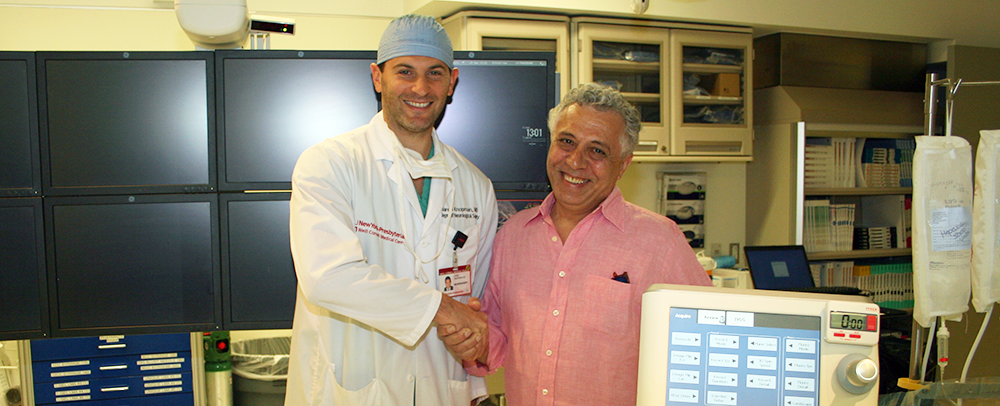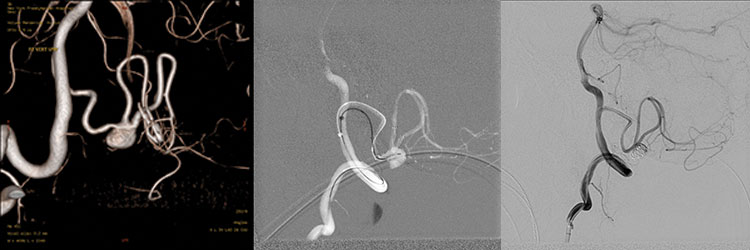
Alain Suissa wasn’t terribly surprised to wake up with a headache one Saturday morning in 2013. After all, the 57-year-old New Yorker had been out with friends the night before and had had a couple of drinks. “I thought it was the cheap vodka,” he says, “so I took a couple of Advil and waited for the headache to pass.”
The next morning, though, he still had the headache. As he waited for a friend to come by for a planned museum visit, Alain hung up from a phone call — and in that instant his life was forever changed.
“I felt something like a cold hand wrapping my brain from the neck up,” he says now. “My legs buckled and I landed slowly on the floor, trying to understand what was happening to me.” Realizing that he was in trouble, Alain gathered all of his strength to unlock his apartment door, then reached for the intercom to ask the doorman to summon an ambulance.
In the emergency room at NewYork-Presbyterian/Weill Cornell Medical Center, Alain was diagnosed with a bleeding aneurysm — a complete surprise, since he had no family or personal history of cerebrovascular disorders. He was transferred to the intensive care unit and introduced to Dr. Jared Knopman, a neurosurgeon who specializes in cerebrovascular disorders such as aneurysms.
Dr. Knopman had to perform open surgery to reach the damaged artery and clip the aneurysm; he also had to connect two other smaller arteries to create an artificial bypass to preserve blood flow to Alain’s brainstem. (See more about clipping an aneurysm.) Alain describes that surgery as “traumatic” and his recovery period from it “heavy duty,” but he recognizes how fortunate he was to have made a full recovery. (About 40 percent of those who suffer a ruptured brain aneurysm will die; more than 60 percent of those who survive will suffer permanent neurological damage.) He was advised to come in once a year for a follow-up scan to monitor the repaired blood vessel, but other than that he resumed his normal life.
It was on Alain’s second follow-up scan, done in January 2015, that Dr. Knopman spotted a second aneurysm. What was particularly surprising was that it had formed at a completely different location than the first one. It’s rare for anyone to develop an aneurysm at all, much less a second one in such a short period of time. Since the aneurysm didn’t appear to be in imminent danger of rupturing, Dr. Knopman had time to review the scans with colleagues and develop the best possible treatment plan.
Performing another open surgery for this aneurysm would have been very risky, as the outside part of the new aneurysm would likely be covered by scar tissue formed during Alain’s first operation; manipulating the tissue could cause the new aneurysm to burst during the surgery. Dr. Knopman decided to treat Alain with a brand-new minimally invasive technique in which he’d use a new intracranial stent to reconstruct the vessel and fix the aneurysm from the inside.

Left: The scan that revealed Alain's second aneurysm. Center: a scan showing the stents across the neck and the microcatheter inside the aneurysm dome about to coil. Right: the result, with coils in the dome and stents in the blood vessel, with blood flow through them.
This procedure was an innovative use of the stent, which was approved by the FDA only last August and had not previously been used in such small blood vessels located so deep in the brain. Evaluating all the treatment options, though, Dr. Knopman decided this use of the new stent was best for Alain. “Despite its novel application, I felt it would be the safest option – and in fact the only viable option – to treat this complex problem,” he says.
Ten weeks after the scan revealed the new aneurysm, Alain underwent the minimally invasive procedure to have the stents inserted, and the new aneurysm coiled. Dr. Knopman used two of the new “Low-Profile Visualized Intraluminal Support” (LVIS) self-expanding stents and crisscrossed them in two tiny blood vessels at the base of the aneurysm. That generated a protective barrier that allowed him to insert tiny platinum coils into the aneurysm bubble, thereby curing the aneurysm while preserving blood flow through critical unaffected arteries. (See more about coiling an aneurysm.)
Alain’s wife had been overseas, but she flew back to be by his side during the surgery and recovery. They both knew that the stakes were high.
“It was such a delicate, unprecedented surgery, in a zone of the brain that affects so many things, such as movement coordination, vision, and speech, that of course I was scared,” says Alain. “I was afraid something would go wrong during the surgery and that I would wake up from the anesthesia handicapped. On the other hand, I had such tremendous confidence in Dr Knopman that I went into the operating room reassured and confident that he was going to save me again, as he had told me.”
The procedure went exactly as Dr. Knopman had planned. The stents were successfully placed, the aneurysm was coiled, and proper blood flow was restored. As stressful as the prospect of a second procedure had been for Alain, recovery from the minimally invasive surgery was much easier than it had been the first time around.
“It was nothing compared to the intracranial surgery,” he says. “This time there was literally no recovery period at all. I felt I was ready to go home the same day.” Alain stayed in the hospital for observation for only two days, which is typical after a minimally invasive procedure, as opposed to the nearly week-long hospital stay required after open cranial surgery. By the morning after his surgery, Alain was “doing laps” in the ICU and enjoying his morning coffee by the window.
Alain will turn 60 this summer, and he says he’ll do so with an entirely new approach to life. “I was extremely stressed and anxious before,” he says, “and now I am very grateful, very appreciative of simple, everyday things. I feel such a huge relief to have come out of this unharmed, and fully operational.”
Knowing as he does now that he is prone to growing aneurysm, Alain also vows to “stay away from annoying situations and irritating people.” Dr. Knopman laughs and says he can’t help Alain with that — especially in New York — but he does promise to continue to monitor the blood vessels in Alain’s brain, ever vigilant for any new signs of trouble. Alain says he has no doubt what surgeon he wants overseeing his care.
“I would tell anyone who is diagnosed with an aneurysm to get to Weill Cornell right away,” he says. “And ask for Dr. Knopman.”